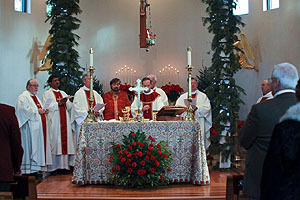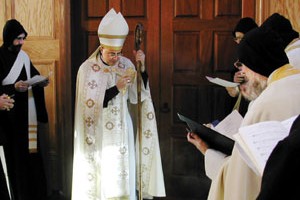Prayer is a reality that is initiated through the salvific dynamism of God’s grace. Our prayer is not about us heroically turning to God, but rather us responding to God’s activity. This activity is initiated through our insertion into God’s triune life at Baptism and is nourished by the grace offered in the Eucharist. Thus our prayer is about learning to respond to a reality that has been given to us through the mediation of the Church.
Among Christian writers and saints throughout the ages, the Eucharist has been considered the pinnacle of what is called the Liturgy. Through our entering into the Eucharistic celebration, we penetrate the divide that prevents our limited human nature from partaking of the Divine nature, and we enter into the on-going exchange of the Father, Son, and Holy Spirit. Thus the liturgy is our participation in God’s divine life.
Often, this participation precedes our conscious awareness. Many of us entered the Church when we were baptized as infants. In such cases, the reality of prayer was present in our lives before we had the vocabulary to express it. This provides a helpful way of understanding that although prayer is populated by ideas, concepts, images, and other ways in which we experience reality, its foundation is one that goes beyond our consciousness.
Growth in holiness is not necessarily about “adding” something on to what we were given in Baptism, but rather about allowing the Holy Spirit to peel away the layers of attachments, egocentricity, and sin in our lives so that we might enter fully into the mystery of the liturgy. As we learn to enter into this mystery, our lives become transfigured by the light of Mt. Tabor, which is the transformative power of God’s love.
This is Chapter 3 from my on-going book Christian Meditation: Discovering the Light of Mt. Tabor












No Comment